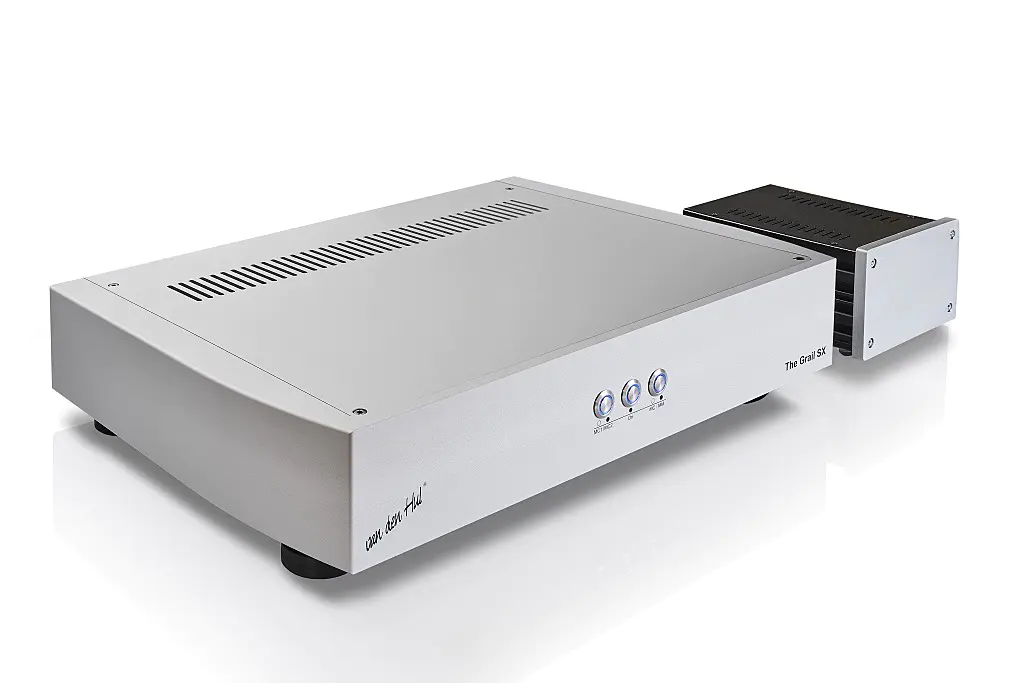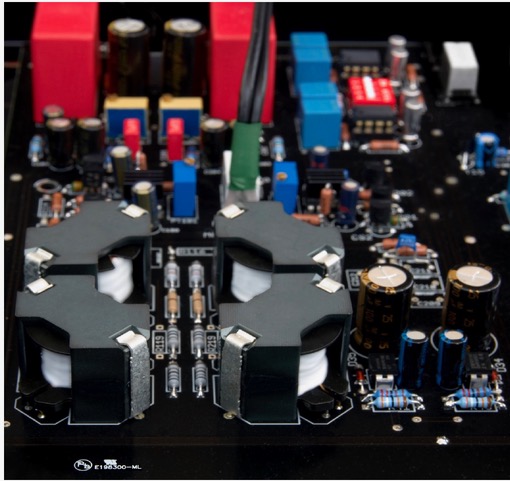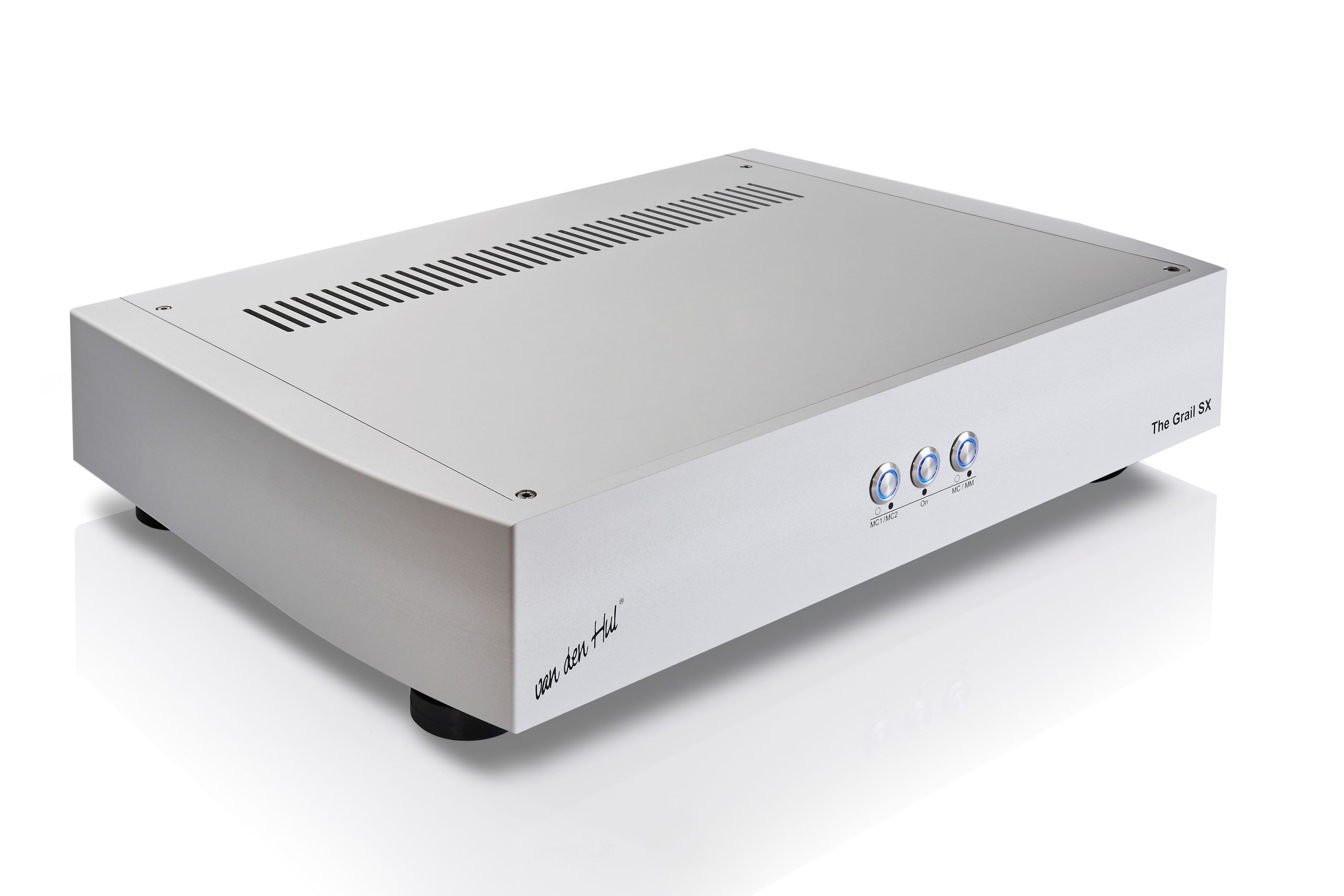A Holy Upgraded The Grail SX
an updated circuit and a more convenient operating system
Many Grails ago, in 2009, van den Hul introduced its original "The Grail" transimpedance-based MC/MM phono preamplifier. I reviewed it in 2018 when it cost $7950. Yes, it’s pretentious to name anything, but especially an audio product, “The Grail” but at least it wasn’t called “The Holy Grail” and it wasn’t packed in a cup and didn’t promise mystical healing powers. But it surely did deliver the promised outstanding sonic performance and it's still in production, now costing $8995..
That original “The Grail”, featuring gracefully sculpted wooden side “cheeks” and a white “pebbly finished” aluminum main chassis plus “basic black” outboard power supply, offers a single-ended current amplification-based MC input and a single-ended voltage based MM input as well as capacitor-free inductor-resistor based RIAA filtration among a host of useful circuit attributes.
A seriously upgraded version, The Grail SE+ ($23,995), which I reviewed in 2020, included dual mono circuitry, improved power supplies, and added a choice of balanced XLR or single-ended RCA in one of its two current-based MC inputs and balanced-only in the second MC input plus a single-ended moving magnet voltage amplification-based input. van den Hul also sells a “The Grail SE” ($19,995) dual-mono version and “The Grail SB” ($16,995) fully balanced edition.
When I first reviewed “The Grail” I assumed that it was not designed by Mr. A.J. van den Hul, who to the best of my knowledge is not an electrical engineer. That proved correct when I heard from German engineer Jürgen Ultee who told me in an email that he was the “hired hand” designer of The Grail as well as of many other products badged with familiar brand names, though for obvious reasons he would not name them.
There’s absolutely nothing wrong with this arrangement for van den Hul or for any other company that contracts with Mr. Ultee or any other similarly situated "for hire" designer. Having reviewed three The Grail iterations designed by Mr. Ultee, clearly he is a seriously talented man!
Introduced last August (2023) the new van den Hul The Grail SX is a sleeker-looking all metal chassis, satin aluminum finished design featuring a single umbilical connected external power supply and no wooden side “cheeks”. It costs $28,995 or $5000 more than The Grail SE+.

The new Grail SX features a "redesigned" circuit board, which van den Hul claims significantly improves sound quality, providing enhanced sound staging and "airiness". The new board also provides for "mixed-mode operation" meaning when using a balanced XLR input the signal is available at both balanced XLR and single-ended outputs and both can be simultaneously used. The same is true of the single-ended inputs, for which both the single-ended and balanced outputs are available and can both be simultaneously used.
Here’s The Grail SX feature list found in the useful PDF manual:
Feature list:
a specific designed Phonograph preamplifier section, unique in the world
balanced design for inputs and outputs
inputs: three Phonograph inputs, two balanced for MC cartridges, one for MM (unbalanced)
Phonograph RIAA - equalization with coils only, no sound impairing capacitors in filters
special printed circuit board material with gold conducting paths
special equipment foot made of selected wood avoids mechanical energy storage
low noise moving coil input stage, less annoying noise even with low-output cartridges
automatic adapting MC input stage for moving coil cartridges, no matching resistors needed
possibility to compensate phonograph cartridge sensivity (level adjustment)
strictly separated amplifier sections and circuit layout deliver a very natural soundstage
power supply with Gyrators for each amplifier stage delivers very high noise cancellation
the external power supply works with 120V and 240V mains voltage (reversible inside)
Though it doesn't specifically say so, The Grail SX's MC inputs, as with previous "The Grails", feature current source, not voltage-based amplification circuitry, designed to maximize the capabilities of low-output, low-internal-impedance MC cartridges. Once-esoteric, this feature is no longer "unique in the world", though it's possible the instructions refer to something else.
van den Hul claims the circuit is appropriate for low output MC cartridges with internal impedances ranging from 10 to 400 ohms. As with the original Grail, this one features capacitor-free, L-R (inductor-resistor) RIAA filters.
 The coil-based, capacitor-free RIAA filter
The coil-based, capacitor-free RIAA filter
The Grail SE+'s dual chassis outboard power supplies are replaced here by a single one; the SE+'s internally mounted DIPswitches allowing settings for 56, 64, 70 and 73dBs of gain, have been replaced with a dual switch (one per channel), that gives you the choice of 52, 60 and 66.5dBs of MC gain (20dB less into the MM input). Those handy with a soldering iron can change the MM input's impedance from the standard 47kOhms or add capacitive loading if need be.
Setting Up and Operating The Grail SX
I connected The Grail SX to my preamp using its balanced outputs and used both its single-ended and balanced MC inputs. The default gain setting is 60dB and that proved more than sufficient for the lowest output moving coil cartridges I used with it.

A clean back panel makes connecting everything easy unless your tonearm connecting cables are of the "narrow Y" variety like the set below, in which case they will not be useable due to the back panel's dual mono layout that places the left and right channel inputs a good distance apart.

Three buttons on the front panel control everything. The center button turns the unit on and off. The button to the right selects MM or MC, while the one to the left selects MC1 or MC2. Simple! And since there are no loading options, The Grail SX is essentially "plug and play". The only caution: mute your preamp before switching between inputs or you might experience a loud "pop".
Compare that to my description of using SE+ : "The back panel is very busy, with 12 jacks, two umbilical connectors, and a pair of toggle switches (one for MM/MC and the other for choosing which of the two MC inputs is active) placed in close proximity to one another...If you have two MC-cartridge–fitted arms connected, you'll reach behind, find the toggle switch, and throw it to select between them. If you have a third arm fitted with an MM cartridge, you'll throw the other toggle switch. If you use the single-ended inputs, you must use the single-ended outputs." In other words, big operating system upgrade!
The Sound: Black as Night, Black as Coal
How can I compare the previously reviewed SE+ with the new SX? I cannot. It was much easier to compare the original single-ended The Grail with the far more ambitious, costly and fully balanced SE+. While it wasn't fair comparing the original The Grail to the far more costly CH Precision P1/X1 combo, that did highlight The Grail's lesser dynamic "slam" and its looser less extended lower octaves and its comparative overall lax musical grip.
The SE+ produced obviously greater macrodynamic slam that rivaled that of the P1/X1 combo and its bottom octaves were bold, deep and well-defined. The SE+'s midrange clarity and "see into the stage" transparency was likewise more similar to that of the CH Precision and its ability to cleanly delineate instruments in three-dimensional space without adding unnatural edge definition.
At this point based on my experience with them, I think that low output, low internal impedance cartridge enthusiasts need to at least experience a trans-impedance phono preamplifier in their own systems even if it's one of the least costly. All of them, regardless of price, produce background quiet that only the best voltage-based phono preamps manage. There's another attractive quality all that I've heard also share, and that's a surprisingly sophisticated delivery of high frequency transients—never edgy and overly defined or "antiseptic" as many voltage based ones produce, nor soft and ill-defined as lesser tube-based phono preamps produce.
On the other hand, unlike with voltage-based phono preamps where you can change loading and sometimes affect top end balance, with transimpedance-based phono preamps you are stuck for better of worse with what you get. What I've gotten from all of them regardless of price is an almost tube-like "just right" transient liquidity and overall transparency. The better ones do it better and The Grail SX is up there with the better ones.
Macro-dynamic performance here is powerful, and effortless and image three-dimensionality and sound staging both leave little to be desired. Right now I'm playing a gatefold copy of Basie Jam #2 (Pablo 2310-786) recorded May 6th, 1976 at RCA studios, Los Angeles. These are fun, mid-size band jam sessions featuring great players: Basie, Louis Bellson and John Heard rhythm section plusBenny Carter, Eddie Lockjaw Davis, Clark Terry, Al Grey and Joe Pass. Can't go wrong with that group, though they are all past their youthful prime.
I'm listening to "Doggin' Around": Joe Pass hanging in 3D to the right of the left speaker, Clark Terry on the other side and Bellson way back stage center. It's silly how "in the room" Terry is, doing a long, deft circuitous solo with Basie laying low behind him and Heard dealing nimble bass notes. Everyone's having fun jamming, they're all and it's as close to being there as it gets. Images are filled in and not at all skeletal, transients are well-defined and not edgy, instrumental harmonics are rich and believable and when Bellson does a solo towards the end of the track the hits stay where they are in the confined space in which he's been placed to avoid leakage—and you can clearly hear that too.
Completely shifting gears, moving on to chamber music, I played a few sides of an 8 LP ERC mono box set of Mozart Sonatas for Piano and Violin performed by the Lili Kraus and Willi Boskovsky recorded some time in the 1950s for the French label Les Discophiles Francais (Boskovsky was also the Concertmaster of the Vienna Philharmonic from 1939-1971 and sort of a Guy Lombardo sophisticate who conducted New Year's Eve concerts with the orchestra, mostly playing Strauss waltzes, released on British Decca).


The delicacy of the violin and piano recording is a test of both The Grail SX's timbral accuracy and its presentation of microdynamics. Here was the main area where the $76.000 CH P10 was clearly better but at quite a cost. While The Grail SX pleasingly delivered both piano and violin textures and timbres, the CH produced greater "see through" transparency, more vibrant string textures and a more convincing piano sound, with attack delicacy, much improved sustain and decay.
Microdynamic deficiency for whatever reason or reasons is the only overall criticism I can offer about The Grail SX's sonic performance. It "gives up the ghost" at the bottom of the dynamic scale. It's something you don't hear as much as you sense as a "delicacy loss" and it's not related to the noise floor so don't ask me what it is, or that unless you listen to the CH P10 or another phono preamp at that performance and price level you're going to hear it. But going between The Grail and the P10 makes it obvious.
It was easy to hear on the reissue of Yusef Lateef's Eastern Sounds (previously reissued as a "Small Batch" one-step and now as a less costly OJC CR00615). On the opener, "Plum Blossom", there's a percussive tapping produced by an unidentified instrument. The attack and sustain of tap sound produced by the two different preamps made clear the microdynamic difference and now I'll stop going on about it because it's only an issue if the rest of your front end and system resolves everything.
Otherwise, The Grail SX is one of those rare and most attractive "gets out of the way and lets your transducer of choice do its thing" phono preamplifier. If you want yours to add a "touch of warmth" or "a bit of sparkle", The Grail SX might not be for you. it's as neutral an arbiter of timber, texture and transient attack as you're going to hear from a MC phono preamplifier. Its rhythmic authority produces the desired toe taps. When I plugged various cartridges into the very fine phono input of my darTzeel NHB-18NS preamplifier, the overall sound got somewhat more supple and soft and some might prefer that to The Grail SX. On some records I did as well. It's a very good "built in" phono preamp but for rhythmic drive, and tightly sprung drive, The Grail SX was the clear winner.
Conclusion
$29,995 is a lot to pay for a phono preamplifier. The Grail SX give you a lot: three inputs—two single-ended and balanced trans-impedance MC inputs and one single-ended voltage gain-based MM input. It doesn't include a subsonic filter or a "mono" switch so despite the cost it's very "basic", but the sonic performance is "get out of the way" neutral timbrally and it features controlled, full bottom end slam that if your cartridge and the rest of your system can deliver it, bass performance you'll fully appreciate with every record you play that you expect good things from on bottom.
The Grail SX never sounds thin, or antiseptic or "clinical". We've all heard those and the usual "work around" is a warm-ish cartridge. I never felt the need to insert one of those though I have a few. Still, if you are a tube person, The Grail SX might not be what you're looking for unless you are thinking about what a great solid state phono preamp might bring to your system. If you mostly listen to rock or jazz, you'll really appreciate what The Grail SX will deliver. But it does an equally credible job on classical music. Enough for the "warmth" folks? Perhaps.
The Grail will bring to the picture quiet, black backgrounds, rhythmic organization, macrodynamic "slam" and solidity, sophisticated textural performance, solid, three-dimensional imaging, generously wide and deep sound staging and very little if any of a sonic personality of its own. That's what most of us are looking for. Or at least we say we are. If you can find a way to audition The Grail SX at home and you're comfortable at the price, give it a listen!
Specifications
Mains power:120Volts or 240Volts, 50/60Hz
Power consumption:appr. 15 Watts
Temperature operating range:from 15deg. Celsius up to 35deg. Celsius room temperature. No condensation permitted
Use only in dry rooms
Max. undistorted output voltage (< 1%):15Vss for MM signal path, 8,5Vss for MC signal path
Output impedance:330 Ohms at RCA Cinch, 20 Ohms at balanced out
Input sensivity values:given for 250mV RMS resp. 0,707Vss output level on amplifier output
Signal to noise:> = 80dB(A) at lowest amplification factor
Input voltages at denoted input to achieve 250mV output level
MM input:
at amplification factor 32dB: 6,2 mV
at amplification factor 40dB: 2,5 mV
at amplification factor 46,5dB:1,2 mV
Input impedance: 47KOhm / 50pF
MC input:
at amplification factor* 52..56dB: 0,62 mV
at amplification factor* 60..64dB: 0,25 mV
at amplification factor* 66,5..70,5dB:0,12 mV
* = true amplification factor varies with source impedance of MC cartridge about appr. 4dB
Input impedance: autom. matching from appr. 10 Ohms up to 400 Ohms
Weight:13,5Kg (appr. 29,8lbs) without the ext. power supplies
Size (WxHxL, incl. feet):475 x 95 x 335mm
______________________________________________________________________________
Manufacturer Information
van den Hul BV:
Oude Apeldoornseweg 6g 8171 LV Vaassen The Netherlands.
Tel: +31 578 569 950.
Web: vandenhul.com.
US distributor: AudioShield Audio Distribution.
Web: Audioshield.com









































